The proceedings paper on our presentation made at the fourth conference on Artificial Light at Night was published on the International Journal of Sustainable Lighting.
The proceedings paper on our presentation made at the fourth conference on Artificial Light at Night was published on the International Journal of Sustainable Lighting.
[TO BE TRANSLATED]
Fossimo stati in Danimarca, non sarebbe stato un grosso problema, ma la pioggerellina (a volte “come le funi”) e la nebbia con visibilità 10 metri nelle strade del Rally di Maremma non hanno incoraggiato la partecipazione al ritrovo “da Giannino” sabato e domenica scorsi.
Ciononostante, un po’ di persone sono venute, ed erano quelle giuste. Magari quattro o cinque in pù ci potevano stare, ma già dieci in più, con questa stagione, avrebbero determinato senza volerlo un ambiente meno godibile.
Nella somma della due giorni, abbiamo consumato una metà delle provviste sarde, tre quarti delle schiacce farcite del forno, non abbiamo finito i due boccioni di vino da tavola (rosato di Dorgali e rosso della Trexenta). In parallelo, ci sono stati vari scambi e interazioni, a base di chitarre, enciclopedie degli anni Settanta, artisti di strada (in borghese e fuori servizio), piemontesi in trasferta per amore, e preparativi di trasferte in Piemonte per amore (della musica). Si è discettato di Woody e Arlo Guthrie, frane sopra Baunei, Diodoro Siculo, lavorazione del granito, musica grunge e altri temi che ora sfuggono. Per quattro ore di due giorni…Non era un’osteria, non era un caffé letterario, non era un simposio, non era una Winter School. Qualcosa era. Magari si ripete.
Per domande specifiche: info@pibinko.org 
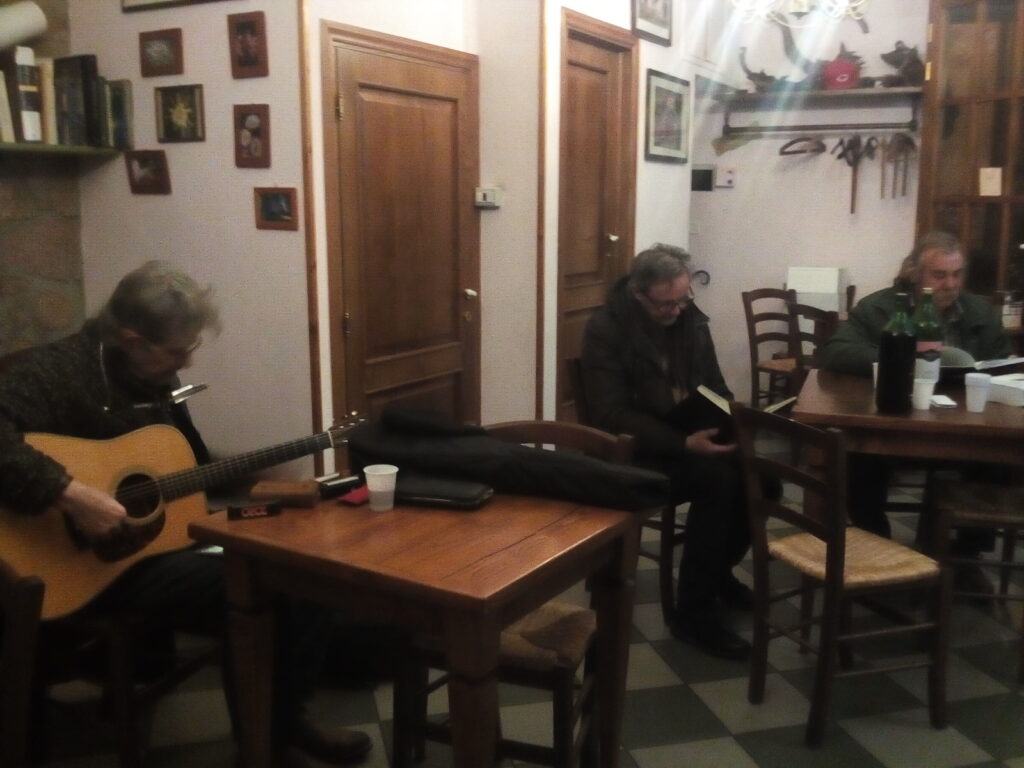


Fa’ la Cosa Giusta is the biggest and most widely known Italian Fair on sustainable lifestyles. Between 3 and 4PM on Saturday, March 2017, you can find us there with an event which, as usual, will be considered too long by communication and marketing experts.
This is not the first time that I participate in this event.
In 2008 I was invited to present the experiences of Palla 21 in Chicago and m(‘)appare Milano for the tenth Avanzi anniversary.
A couple of years later I was part of the Ortinconca team, a group of milanese citizens committed to urban gardening with ancient seeds (for whom I created an open-source web map of the seed distribution map).
But this is the first time that we have an event in the cultural events section of the fair, together with team we work in since 2006, and completely focused on our own projects.
a) The fair’s web site has an event description in Italian . which we are translating here for your convenience:
When: Saturday, March 2017
Where: Piazza Viaggiatori
Event type: meet-up
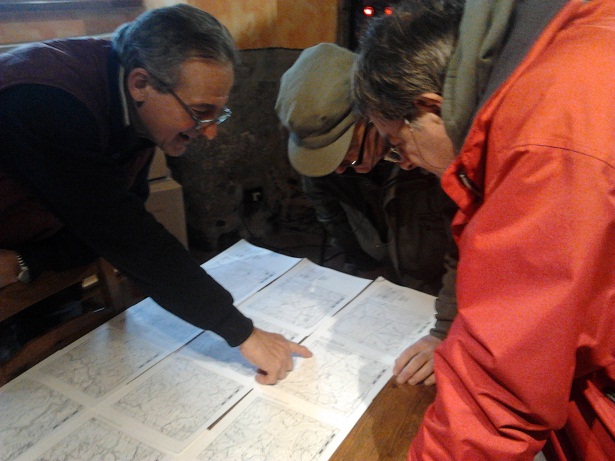 This will be your next chance to get to know the map of light pollution (BuioMetria Partecipativa) and the community map of the Farma Valley, created by the residents of this lesser known corner of Tuscany, 45 minutes South of Siena (or two hours South of Florence, you choose).
This will be your next chance to get to know the map of light pollution (BuioMetria Partecipativa) and the community map of the Farma Valley, created by the residents of this lesser known corner of Tuscany, 45 minutes South of Siena (or two hours South of Florence, you choose).
With: Andrea Giacomelli, plus two or three mappers of Earth, Sea, and Sky
Andrea Giacomelli (aka pibinko), since 2006 has been creating and managing projects on interdisciplinary protection and promotion of lesser resources.
The other guests will be active members coming from the communities which are participating to the BuioMetria Partecipativa and Farma Valley Community Maps.
Organised by: pibinko.org
Admission: free (but you need to have a ticket to enter the fair)
For information and reservations: info@pibinko.org
b) Read a short presentation concerning the event, by Giancarlo da Miele:
 Some call the maps, some call them charts. Whichever way, we use them to save a trace, to understand a context, to inspire a walk, to plan a military strike of the remediation of a contaminated site, to decide where we should irrigate more, an where we should irrigate less. Maps in relation to space are like calendars in relation to time: they are tools to provide boundaries and references in one or more dimensions. As any tool, we can find maps which are designed and produced “top-down” or “bottom-up”. You can build a jet airliner or a paper plane. With both you can make a journey. What will change is how much you spent to reach your destination.
Some call the maps, some call them charts. Whichever way, we use them to save a trace, to understand a context, to inspire a walk, to plan a military strike of the remediation of a contaminated site, to decide where we should irrigate more, an where we should irrigate less. Maps in relation to space are like calendars in relation to time: they are tools to provide boundaries and references in one or more dimensions. As any tool, we can find maps which are designed and produced “top-down” or “bottom-up”. You can build a jet airliner or a paper plane. With both you can make a journey. What will change is how much you spent to reach your destination.
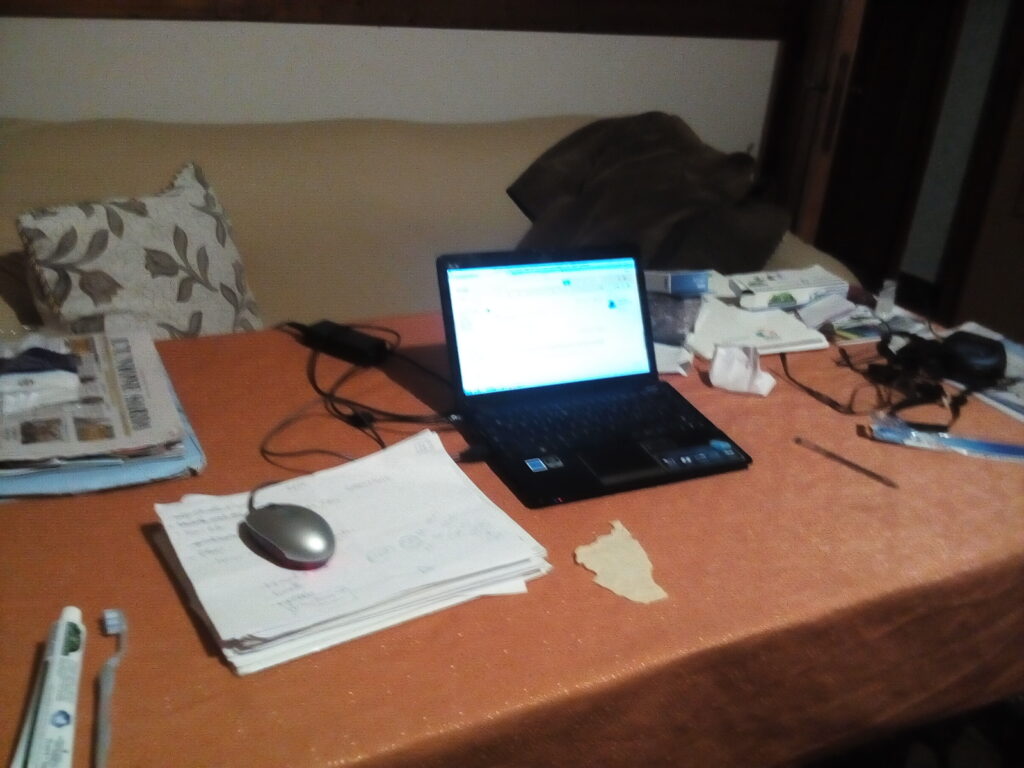
The presentation will propose some of the experiences in creating maps by a team which, since 2006, has been collating experiences from very diverse paths.
Some are “high-level”, and some are “low-level” (according to the concepts of “high” and “low” circulating in Europe in the past 70 years: PhD grants in hydrology, sledgehammer grants in construction sites, Science and Technology parks in Southern Italy, timber men working right next to natural protected areas in Southern Tuscany. Put all these experiences in a cultural blender, mix them for ten years, and apply the result to map making, pouring a little each year. Our survey is not yet complete, but we have parts of Earth, Sea, and Sky to show, and we need a hand to keep on tracing our rout to the Valley that’s not there.
c) Since we need to be in Milano on March 11, we expect to reach the city at least one day in advance, and will not have to rush back to Toscana, so we might stay one or two days after the event. If you are not able to attend on March 11, but are interested to take up our challenge on participatory earth, sea and sky survey, let us know (info@pibinko.org or +39 351 133 7020).
[TO BE TRANSLATED]
4 febbraio 2017, ore 19 circa
 A margine del resoconto sul viaggio dalle rocce rosse di Arbatax alle rocce grigie di Roccatederighi, può anche capitare che Wolfgang Scheibe (detto Steppenwolfgang) e Pietro Crivelli (al secolo Peter Seeds) si trovino in frangenti come questo. Basso monocorda e monotutto, guitar-lele e chitarra LAG importata dalla Corsica (assieme a salamini, vinelli e formaggi sardi). Il tutto sarà stato un quarto d’ora tra la degustazione, le mappe delle isole e qualche foto proiettata su un lenzuolo spiegazzato. La situazione è migliorabile, ad esempio si può spiegazzare il lenzuolo un po’ di più.
A margine del resoconto sul viaggio dalle rocce rosse di Arbatax alle rocce grigie di Roccatederighi, può anche capitare che Wolfgang Scheibe (detto Steppenwolfgang) e Pietro Crivelli (al secolo Peter Seeds) si trovino in frangenti come questo. Basso monocorda e monotutto, guitar-lele e chitarra LAG importata dalla Corsica (assieme a salamini, vinelli e formaggi sardi). Il tutto sarà stato un quarto d’ora tra la degustazione, le mappe delle isole e qualche foto proiettata su un lenzuolo spiegazzato. La situazione è migliorabile, ad esempio si può spiegazzare il lenzuolo un po’ di più.
Vediamo cosa oggi pomeriggio (domenica 5 febbraio dalle 18 alle 20, all’Osteria da Giannino), nella seconda puntata del telefilm.
Per informazioni: info@pibinko.org o 351 133 7020
[TO BE TRANSLATED]
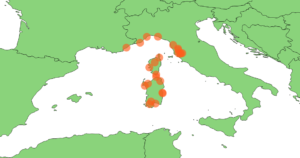 Se non avete la tracheite, sabato 4 e domenica 5 febbraio potete venire la trachite a Roccatederighi, frazione di Roccastrada (GR) a sentire e gustare dal vivo il resoconto della missione per m(‘)appare la Sardegna svolto dal 9 al 29 gennaio scorso.
Se non avete la tracheite, sabato 4 e domenica 5 febbraio potete venire la trachite a Roccatederighi, frazione di Roccastrada (GR) a sentire e gustare dal vivo il resoconto della missione per m(‘)appare la Sardegna svolto dal 9 al 29 gennaio scorso.
Il luogo non è scelto a caso, dato che è praticamente equidistante da tre centri importanti per lo svolgimento della recente missione sulle isole: Tatti, Torniella/Piloni e Roccastrada.
L’appuntamento è dalle 18 alle 20 tutti e due i giorni, al bar da “Giannino”. Ci sarà modo di vedere un po’ di foto e filmati, degustare modiche quantità di formaggi e vini procurati durante il viaggio, al netto di qualche salamino già consumato nella preparazione degli eventi (…non si vive di solo pane…ci vuole anche un po’ di salame).
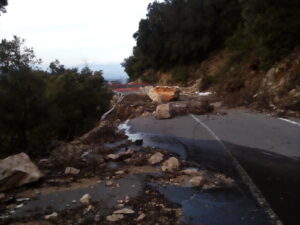 Particolare attenzione sarà data al tema dell’accessibilità: come fare a lavorare fra Toscana, Corsica e Sardegna d’inverno? Traghetti che saltano un giorno sì e uno no, frane tra Baunei e Dorgali, che quelle in maremma al confronto sembrano castelli di sabbia sulla spiaggia di Follonica, turiste fai da te che si perdono viaggiando con mezzi poco sicuri in territori non sempre sicuri (dal punto di vista idrogeologico), metri di neve in Corsica che fanno saltare appuntamenti di lavoro. Il Tirreno sarà pure il santuario dei cetacei e uno dei paradisi estivi per i turisti, ma per un trasfertista può essere un purgatorio tendente all’inferno: d’inverno condizioni difficili, d’estate tariffe e traffico che spesso ignorano esigenze di residenti e lavoratori.
Particolare attenzione sarà data al tema dell’accessibilità: come fare a lavorare fra Toscana, Corsica e Sardegna d’inverno? Traghetti che saltano un giorno sì e uno no, frane tra Baunei e Dorgali, che quelle in maremma al confronto sembrano castelli di sabbia sulla spiaggia di Follonica, turiste fai da te che si perdono viaggiando con mezzi poco sicuri in territori non sempre sicuri (dal punto di vista idrogeologico), metri di neve in Corsica che fanno saltare appuntamenti di lavoro. Il Tirreno sarà pure il santuario dei cetacei e uno dei paradisi estivi per i turisti, ma per un trasfertista può essere un purgatorio tendente all’inferno: d’inverno condizioni difficili, d’estate tariffe e traffico che spesso ignorano esigenze di residenti e lavoratori.
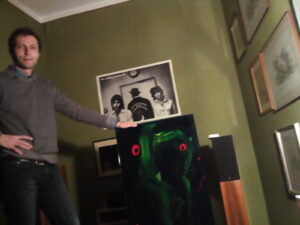 In tutto ciò…non ci si incupisce: come sempre, e in particolare a partire dal Festival d’Inverno in Val di Farma del 17-18-19 dicembre 2016, la musica troverà un proprio spazio, non definibile a priori, ma nemmeno negabile, stante la quantità di musicisti passionisti e professionisti che stanno gravitando attorno a questi eventi.
In tutto ciò…non ci si incupisce: come sempre, e in particolare a partire dal Festival d’Inverno in Val di Farma del 17-18-19 dicembre 2016, la musica troverà un proprio spazio, non definibile a priori, ma nemmeno negabile, stante la quantità di musicisti passionisti e professionisti che stanno gravitando attorno a questi eventi.
Nel corso della “due pomeriggi” si daranno inoltre gli aggiornamenti sul calendario eventi e iniziative 2017 del gruppo pibinko.org + Attivarti.org + affini, consultabile anche online alla pagina: http://www.pibinko.org/calendario/
Ultimo, ma non ultimo, almeno per il sabato: le schiacce e i prodotti da forno disponibili a 40 metri dal ritrovo, tra i più buoni nel raggio di 50 chilometri (a detta di uno che di forni e di bar ne frequenta diversi per spostamenti di lavoro). La domenica il forno è chiuso, e quindi regolatevi.
La partecipazione all’evento è libera e gratuita, ma la capienza è limitata: è quindi gradita conferma della partecipazione scrivendo a info@pibinko.org o chiamando il 351 133 7020
[TO BE TRANSLATED]
sottofondo musicale: Southern Cross, di Crosby, Stills e Nash
Torniella (GR) – 29-1-2017
Stamani verso le 05:30 ora italiana nelle campagne attorno a Torniella (GR) è abboscata (non si può dire ammarata, ché il mare non c’è, ma di boschi quanti vi pare) la capsula lanciata il 9 gennaio scorso dalla base di Sureplain, Farma Valley, per la missione esplorativa m(‘)appare la Sardegna.
 Al timone del monovolume, il buionauta Giancarlo da Miele, che ha percorso nei 21 giorni di spedizione circa 2300 km in auto, più tratte di traghetto per circa 700 km. Raccolte misure buiometriche, campioni di formaggi e salumi, e guide a varie risorse del territorio che saranno successivamente analizzati con i cluster top down dei laboratori di pibinko.org e attivarti.org.
Al timone del monovolume, il buionauta Giancarlo da Miele, che ha percorso nei 21 giorni di spedizione circa 2300 km in auto, più tratte di traghetto per circa 700 km. Raccolte misure buiometriche, campioni di formaggi e salumi, e guide a varie risorse del territorio che saranno successivamente analizzati con i cluster top down dei laboratori di pibinko.org e attivarti.org.
Jack O’Malley, direttore scientifico della spedizione, ha commentato a proposito del buionauta , soprannominato precario o “il preca”: “Il Preca ha fatto quello che doveva essere fatto”. Il da Miele, contattato per un commento, per il momento non si esprime dovendo smaltire una fase di recupero, ma ha inviato un link al filmato di Gianni Bugno quando vinse il mondiale di ciclismo.
 Da Miele ha anche raccolto varie testimonianze fotografiche e video (per tacere di quelle orali e di testa). I circa 2 Gb di video e svariate centinaia di foto , tutto materiale rigorosamente in bassa definizione, sono state trasmesse al centro di elaborazione dati dei pibinko labs…una relazione completa sulla missione sarà disponibile solo tra qualche settimana, ma nel frattempo potete rivedere i messaggi spediti durante i momenti di contatto radio (cfr. tag M(‘)LS sul blog di pibinko).
Da Miele ha anche raccolto varie testimonianze fotografiche e video (per tacere di quelle orali e di testa). I circa 2 Gb di video e svariate centinaia di foto , tutto materiale rigorosamente in bassa definizione, sono state trasmesse al centro di elaborazione dati dei pibinko labs…una relazione completa sulla missione sarà disponibile solo tra qualche settimana, ma nel frattempo potete rivedere i messaggi spediti durante i momenti di contatto radio (cfr. tag M(‘)LS sul blog di pibinko).
Nel frattempo è disponibile il contrasto in ottava rima composto durante il viaggio: http://www.pibinko.org/mappare-la-sardegna-prima-serie/
Prossimo appuntamento: 8 e 9 febbraio a Genova.
Per ulteriori informazioni: info@pibinko.org
 In the afternoon of Saturday, March 4, the Farma Valley will host an event connected to the International Open Data Day.
In the afternoon of Saturday, March 4, the Farma Valley will host an event connected to the International Open Data Day.
The actual location is currently being identified (among various spaces which we and other associations use in the area). More information will be disclosed during the coming days.
Our international Open Data Day will be about the new version of the Farma Valley Community Map. The alpha version of this map was presented on Dec. 18, during the Farma Valley Winter Fest.
On March 4 it will also be possible to provide new input for the completion of the map.
For more information, or should you be interested in participating: mappare@attivarti.org
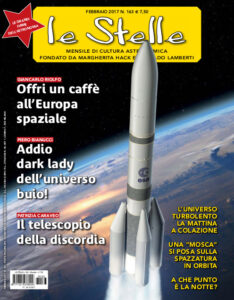 The new issue of “Le Stelle”, one of the two main Italian magazines about astronomy and related topics is available.
The new issue of “Le Stelle”, one of the two main Italian magazines about astronomy and related topics is available.
If you regularly follow the blog posts and the announcements from the BuioMetria Partecipativa project, you will not find breaking news in the article. However, it is an interesting summary of our activities, plus you might be enticed by some of the other topics proposed by the magazine..
Below is the abstract of the article, translated from the magazine’s website :
BuioMetria Partecipativa: environmental monitoring going from Southern Tuscany to Europe and back. The results of the “Loss of the Night” European Project, conducted by common citizens over four years.
Last October the “Loss of the Night” European project was concluded. It was funded by the COST programme of the European Commission, and had started in Fall 2012. The article proposes a summary of the results of the project, with a specific angle on aspects concerning Italy. The scientific community has been acknowledging for years the fact that artificial light at night, if used in excess or inappropriately, will create light pollution and will represent a problem for its effects on human health, fauna, flora, landscape (also the starry sky is part of the landscape) and energy consumption.